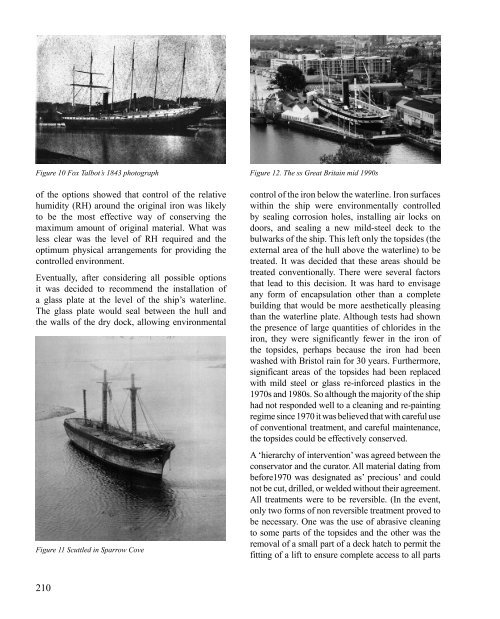dk nkf - Nordisk Konservatorforbund Danmark
dk nkf - Nordisk Konservatorforbund Danmark
dk nkf - Nordisk Konservatorforbund Danmark
Create successful ePaper yourself
Turn your PDF publications into a flip-book with our unique Google optimized e-Paper software.
Figure 10 Fox Talbot’s 1843 photograph<br />
of the options showed that control of the relative<br />
humidity (RH) around the original iron was likely<br />
to be the most effective way of conserving the<br />
maximum amount of original material. What was<br />
less clear was the level of RH required and the<br />
optimum physical arrangements for providing the<br />
controlled environment.<br />
Eventually, after considering all possible options<br />
it was decided to recommend the installation of<br />
a glass plate at the level of the ship’s waterline.<br />
The glass plate would seal between the hull and<br />
the walls of the dry dock, allowing environmental<br />
Figure 11 Scuttled in Sparrow Cove<br />
210<br />
Figure 12. The ss Great Britain mid 1990s<br />
control of the iron below the waterline. Iron surfaces<br />
within the ship were environmentally controlled<br />
by sealing corrosion holes, installing air locks on<br />
doors, and sealing a new mild-steel deck to the<br />
bulwarks of the ship. This left only the topsides (the<br />
external area of the hull above the waterline) to be<br />
treated. It was decided that these areas should be<br />
treated conventionally. There were several factors<br />
that lead to this decision. It was hard to envisage<br />
any form of encapsulation other than a complete<br />
building that would be more aesthetically pleasing<br />
than the waterline plate. Although tests had shown<br />
the presence of large quantities of chlorides in the<br />
iron, they were significantly fewer in the iron of<br />
the topsides, perhaps because the iron had been<br />
washed with Bristol rain for 30 years. Furthermore,<br />
significant areas of the topsides had been replaced<br />
with mild steel or glass re-inforced plastics in the<br />
1970s and 1980s. So although the majority of the ship<br />
had not responded well to a cleaning and re-painting<br />
regime since 1970 it was believed that with careful use<br />
of conventional treatment, and careful maintenance,<br />
the topsides could be effectively conserved.<br />
A ‘hierarchy of intervention’ was agreed between the<br />
conservator and the curator. All material dating from<br />
before1970 was designated as’ precious’ and could<br />
not be cut, drilled, or welded without their agreement.<br />
All treatments were to be reversible. (In the event,<br />
only two forms of non reversible treatment proved to<br />
be necessary. One was the use of abrasive cleaning<br />
to some parts of the topsides and the other was the<br />
removal of a small part of a deck hatch to permit the<br />
fitting of a lift to ensure complete access to all parts

















